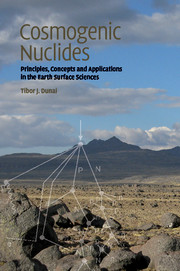Book contents
- Frontmatter
- Contents
- Preface
- 1 Cosmic rays
- 2 Cosmogenic nuclides
- 3 Production rates and scaling factors
- 4 Application of cosmogenic nuclides to Earth surface sciences
- Appendix A Sampling checklist
- Appendix B Reporting of cosmogenic-nuclide data for exposure age and erosion rate determinations
- References
- Index
1 - Cosmic rays
Published online by Cambridge University Press: 29 December 2010
- Frontmatter
- Contents
- Preface
- 1 Cosmic rays
- 2 Cosmogenic nuclides
- 3 Production rates and scaling factors
- 4 Application of cosmogenic nuclides to Earth surface sciences
- Appendix A Sampling checklist
- Appendix B Reporting of cosmogenic-nuclide data for exposure age and erosion rate determinations
- References
- Index
Summary
Victor Hess's experiments in manned balloons in 1912 demonstrated the existence of penetrating radiation entering the Earth's atmosphere from space. Hess's original observation was that gold-foil electrometers carried to an altitude of 5300 m indicated a rapid increase of ionization with elevation. Others confirmed this observation, and in 1925 Robert Andrews Millikan coined the term ‘cosmic rays’. Hess received the Nobel Prize in Physics in 1936 for his discovery.
The term ‘cosmic ray’ is in fact a misnomer; it was based on the belief that the radiation was electromagnetic in nature. During the 1930s it was found that the primary cosmic rays are electrically charged – thus particulate – because they are affected by the Earth's magnetic field. Throughout the 1930s, and until the 1950s, before man-made particle accelerators reached very high energies, cosmic rays served as a unique source of particles for studies in high-energy physics, and led to the discovery of various subatomic particles, including the positron and the muon (Powell et al.1959). Studies conducted during this pioneering phase laid the foundations for the theoretical and phenomenological understanding of cosmic rays as relevant for the use in Earth surface sciences today. Subsequent studies have refined this understanding; a process that is still ongoing.
Origin and nature of cosmic rays
Cosmic rays are high-energy, charged particles that impinge on the Earth from all directions. The majority of cosmic-ray particles are atomic nuclei, but they also include electrons, positrons and other subatomic particles.
- Type
- Chapter
- Information
- Cosmogenic NuclidesPrinciples, Concepts and Applications in the Earth Surface Sciences, pp. 1 - 24Publisher: Cambridge University PressPrint publication year: 2010
- 3
- Cited by



